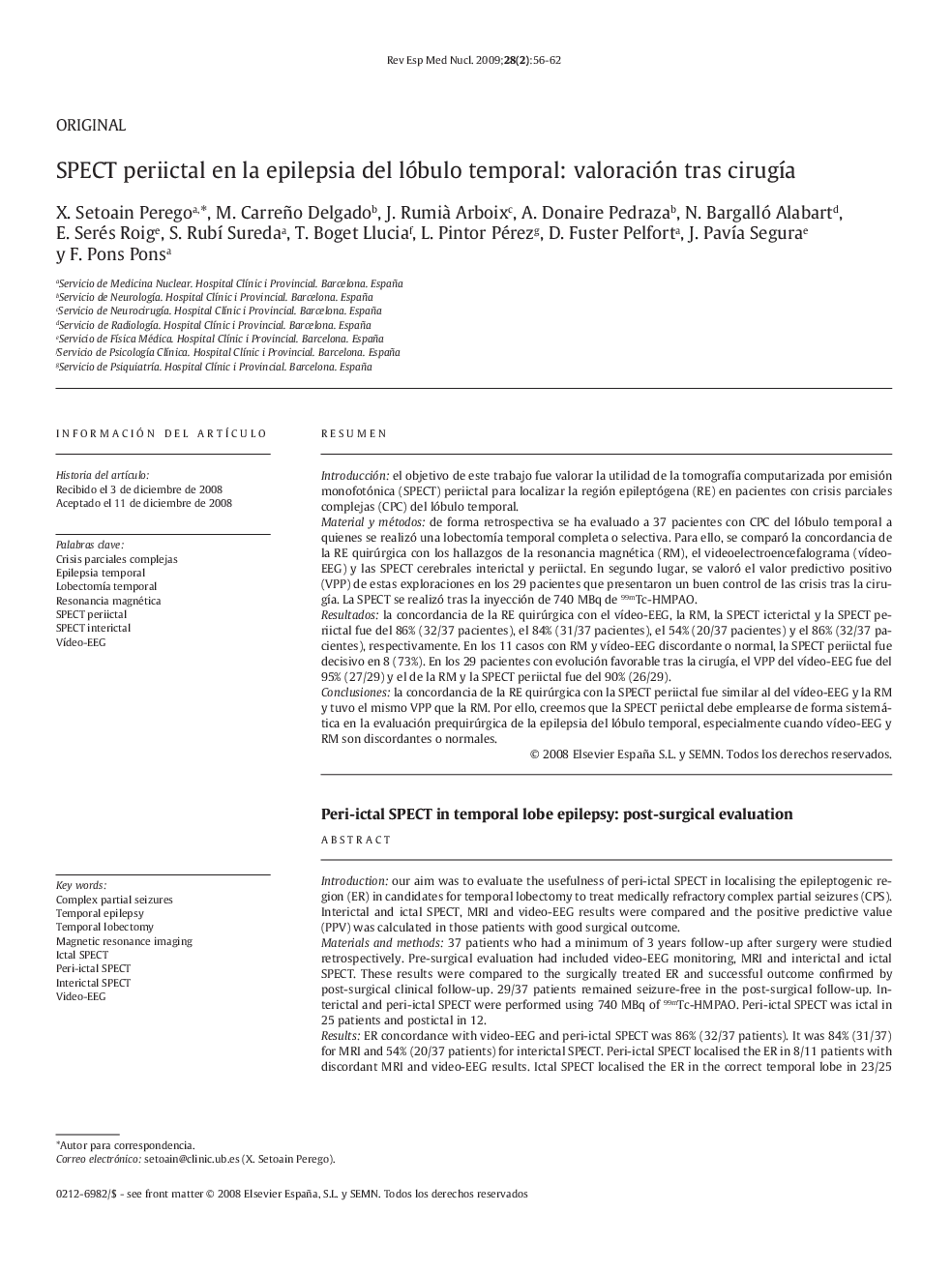| Article ID | Journal | Published Year | Pages | File Type |
|---|---|---|---|---|
| 4249088 | Revista Española de Medicina Nuclear | 2009 | 7 Pages |
ResumenIntroducciónEl objetivo de este trabajo fue valorar la utilidad de la tomografía computarizada por emisión monofotónica (SPECT) periictal para localizar la región epileptógena (RE) en pacientes con crisis parciales complejas (CPC) del lóbulo temporal.Material y métodosDe forma retrospectiva se ha evaluado a 37 pacientes con CPC del lóbulo temporal a quienes se realizó una lobectomía temporal completa o selectiva. Para ello, se comparó la concordancia de la RE quirúrgica con los hallazgos de la resonancia magnética (RM), el videoelectroencefalograma (vídeo-EEG) y las SPECT cerebrales interictal y periictal. En segundo lugar, se valoró el valor predictivo positivo (VPP) de estas exploraciones en los 29 pacientes que presentaron un buen control de las crisis tras la cirugía. La SPECT se realizó tras la inyección de 740 MBq de 99mTc-HMPAO.ResultadosLa concordancia de la RE quirúrgica con el vídeo-EEG, la RM, la SPECT icterictal y la SPECT periictal fue del 86% (32/37 pacientes), el 84% (31/37 pacientes), el 54% (20/37 pacientes) y el 86% (32/37 pacientes), respectivamente. En los 11 casos con RM y vídeo-EEG discordante o normal, la SPECT periictal fue decisivo en 8 (73%). En los 29 pacientes con evolución favorable tras la cirugía, el VPP del vídeo-EEG fue del 95% (27/29) y el de la RM y la SPECT periictal fue del 90% (26/29).ConclusionesLa concordancia de la RE quirúrgica con la SPECT periictal fue similar al del vídeo-EEG y la RM y tuvo el mismo VPP que la RM. Por ello, creemos que la SPECT periictal debe emplearse de forma sistemática en la evaluación prequirúrgica de la epilepsia del lóbulo temporal, especialmente cuando vídeo-EEG y RM son discordantes o normales.
IntroductionOur aim was to evaluate the usefulness of peri-ictal SPECT in localising the epileptogenic region (ER) in candidates for temporal lobectomy to treat medically refractory complex partial seizures (CPS). Interictal and ictal SPECT, MRI and video-EEG results were compared and the positive predictive value (PPV) was calculated in those patients with good surgical outcome.Materials and methods37 patients who had a minimum of 3 years follow-up after surgery were studied retrospectively. Pre-surgical evaluation had included video-EEG monitoring, MRI and interictal and ictal SPECT. These results were compared to the surgically treated ER and successful outcome confirmed by post-surgical clinical follow-up. 29/37 patients remained seizure-free in the post-surgical follow-up. Interictal and peri-ictal SPECT were performed using 740 MBq of 99mTc-HMPAO. Peri-ictal SPECT was ictal in 25 patients and postictal in 12.ResultsER concordance with video-EEG and peri-ictal SPECT was 86% (32/37 patients). It was 84% (31/37) for MRI and 54% (20/37 patients) for interictal SPECT. Peri-ictal SPECT localised the ER in 8/11 patients with discordant MRI and video-EEG results. Ictal SPECT localised the ER in the correct temporal lobe in 23/25 patients (92% concordance). In the 29 patients with a good surgical outcome, the PPV of video-EEG was 95% (27/29) and it was 90% (26/29) for both MRI and peri-ictal SPECT.ConclusionsPeri-ictal brain SPECT is well able to localize ER in patients with temporal lobe epilepsy. Peri-ictal SPECT concordance with ER was as good as video-EEG and MRI and its PPV was as good as that of MRI. We strongly recommend its use in the pre-surgical evaluation of temporal lobe epilepsy, especially when MRI and EEG are discordant.
